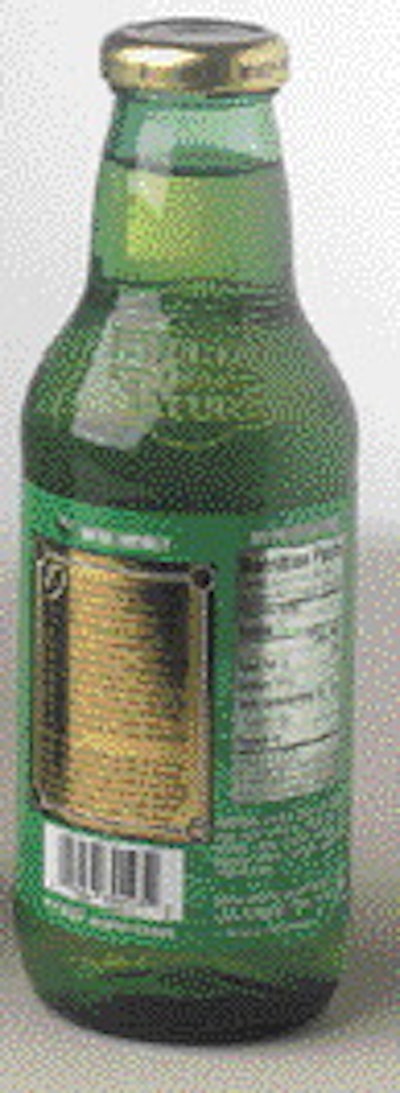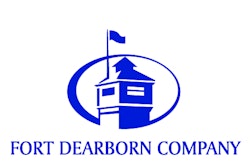Last month, Hansen Beverage Co., Corona, CA, debuted its new line of all-natural, ready-to-drink teas in glass bottles with striking, metallized labels printed by a unique, new six-color process. Fort Dearborn Co. (Niles, IL) offset-prints the labels on a metallized paper substrate using its patented, proprietary HiColour(TM) version of six-color process printing. The new printing method:
* results in cleaner, brighter colors
* eliminates the need for using special line colors
* reduces the cost per thousand
Each of the five different tea labels has its own color scheme, with a deep, two-tone color background depicting artwork of Asian-style dragons. The teas have an Asian-style theme due to herbal ingredients that the ancient Chinese believed to have healthful effects on the body.
All labels are printed on a 57# metallized paper substrate. White, black and gold trim are used for the product name, and the back panel consists of a metallized gold story box and another metallized color (which is different for each label) for the Nutrition Facts box. According to Fort Dearborn, there's nothing especially unique about the label substrate itself.
One of HiColour's main benefits is that Hansen can achieve richer, deeper color tones, without using special line colors. "We're getting truer, brighter and cleaner process colors compared to traditional four-color process," says Steve Clark, marketing manager at Hansen. An example is the gold: "Most people would assume we use a special color to achieve that gold," says Clark. Instead, it is process-printed using the six-color process. "I have yet to see a good gold using four-color process," he adds.
While Hansen's tea bottle labels are using HiColour to eliminate the need for special line colors to provide deeper, richer colors, the labels don't feature a multi-color illustration that takes advantage of the range of colors available with HiColour. For now, the real benefit of HiColour is on-press, where all five labels--each with a dramatically different color scheme--are printed on a common sheet on an offset press.
"We could have printed this label with four-color process," explains Fort Dearborn executive vice president Richard Adler, Jr. "But there's no way we could have matched the colors like we did. You would see a lot more variation and registration movement. There was no way to do the dragon in the background with normal line screening without it resulting in a patterned look due to the conventional line screen."
Adler emphasizes that labels printed via its six-color process are actually more consistent from label to label than using dedicated line colors. How is this possible? "It flies in the face of conventional wisdom," says Adler, acknowledging that line colors provide more consistency over four-color-process printing. "But because we're not using normal screening, and because of the colors that we use, HiColour provides even more consistency [than line colors]."
Clark confirms that labels printed via HiColour are more consistent from label to label. "In terms of special colors, I found it's tougher to balance the four-color process. When you have six colors, it's easier to hit the exact color you want."
Prepress differs
What separates Fort Dearborn's HiColour six-color process printing from four-color process isn't only the press itself. Rather, it's how the artwork is created and separated. "It's all how you manipulate the curves during the color separation process, the scanning, the printing plates you use, and so forth," says Al Presco, president of Fort Dearborn's Niles Div., which prints Hansen's tea labels. Separations, scanning and other prepress functions are handled by Fort Dearborn's Virtualcolor Div. (Elk Grove Village, IL).
The hallmark of the HiColour process is that printed images do not exhibit a dot pattern that's characteristic of conventional 150-line screens used in four-color-process printed images. Packaging World editors were unable to discern any dot pattern on the Hansen's tea labels.
When asked the resolution of the screens used for the HiColour process, Adler sidestepped the question, responding, "Let me put it this way--it's not a normal line screen. It allows for much higher resolution." Citing competitive advantages, Fort Dearborn declined to provide specifics of how the higher resolution screens are developed.
On the press itself, a Mitsubishi offset unit, the main difference consists of using specially formulated inks in a certain sequence on press. The ink colors include enhanced versions of the standard cyan, magenta, yellow and black, plus green and orange.
Apart from that, the changes on press are minimal. "We are not modifying the presses themselves," emphasizes Presco. Indeed, Fort Dearborn plans to use the process on a number of printing presses in several of its plants.
Economics differ
The higher color fidelity isn't without its price. "Prepress costs for each label design are 30 percent to 40 percent higher," acknowledges Adler. But Presco points out that's a one-time charge that is paid back through greater press efficiencies. Hansen's Clark confirms such savings because all five labels are run on one sheet. "We pay a little bit more for setup," Clark says, "but in the long term we certainly save on the cost per thousand." He declined to divulge specifics.
Fort Dearborn's Adler adds that part of the cost savings stems from reduced press changeover. That's because six-color process printing requires fewer special colors. For jobs like Hansen's that require no special colors, the same inks and ink rotations can be used from one customer to the next.
The teas are sold in convenience stores for 99¢ to $1.39. They were rolled out nationwide in June.



























